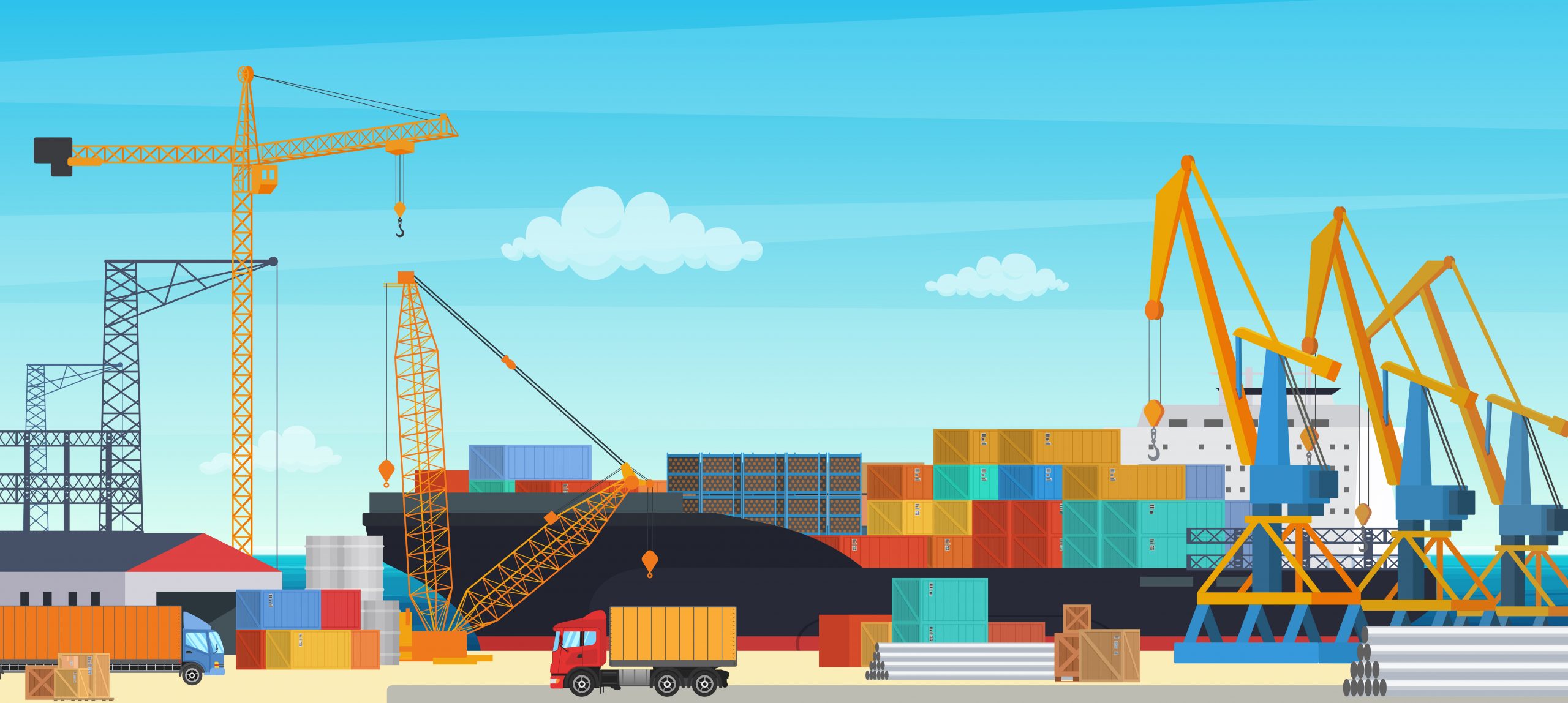In the labyrinth of international trade, a unique lexicon has evolved to help businesses navigate the intricate corridors of global transactions. At the forefront of this lexicon are Incoterms – the set of standardized international commercial terms designed to facilitate trade across borders. But what exactly are Incoterms?
Simply put, Incoterms are a collection of pre-defined trade terms officially recognized in international sales contracts. They primarily detail the roles, responsibilities, and obligations of buyers and sellers in transporting goods. From where the seller delivers the goods to who covers insurance costs, these terms ensure both parties have a mutual understanding, thereby reducing potential conflicts.
Yet, the importance of Incoterms isn’t solely in the nitty-gritty of global contracts. They form a linchpin in the world of international trade, promoting clarity, reliability, and transparency. Whether it’s determining when risk passes from the seller to the buyer or outlining the customs clearance process, Incoterms dictate the essential parameters. They have become indispensable, not just as terms but as a crucial bridge connecting businesses across continents.
Moreover, the undeniable impact of Incoterms on international trade can’t be understated. As the wheels of global trade continuously turn, and as businesses continually seek to expand their horizons, having a standardized set of terms helps simplify and streamline complex processes. Backed by the authority of the International Chamber of Commerce, these trade terms have become the gold standard for businesses engaged in international transactions.
With the world becoming a more interconnected marketplace, understanding the essence and impact of Incoterms is vital. They are not just contractual terms; they are the very backbone of modern-day international commerce.
History and Evolution: From Tradition to Modernity
Every pivotal movement in the realm of business and trade has a rich tapestry of history woven behind it. Incoterms are no exception. Their story is one of transformation, from traditional practices to streamlined modernity, with the aim of facilitating international trade.
The Birth and Adaptation of Incoterms
It all began in the early 20th century, amidst the rise of global trade and the urgent need for standardized international trade terms. Before the inception of Incoterms, traders worldwide used phrases in various languages and interpretations, leading to misunderstandings, conflicts, and hefty legal disputes. There was a palpable need for a consistent language of trade that could bridge this gap, and in 1936, the answer arrived in the form of the first set of Incoterms.
Over the decades, as the face of international trade shifted and as technological advancements paved the way for new modes of transport and trade practices, Incoterms evolved. From the original set, they’ve been revised numerous times – in 1957, 1967, 1976, 1980, 1990, 2000, 2010, and the latest in 2020. With each revision, new terms were introduced, and old ones phased out, ensuring they stayed relevant and mirrored the changing landscape of global trade.
The Role of the International Chamber of Commerce
Behind this evolutionary journey of Incoterms stands a sentinel – the International Chamber of Commerce (ICC). Established in 1919, the ICC perceived the disarray in international trade terms and recognized the dire need for standardization. Thus, the Chamber undertook the mammoth task of drafting the first set of Incoterms.
The ICC has not only been the architect of these terms but their guardian too. It ensured that Incoterms remained updated and in sync with the real-world intricacies of international commercial terms. Their commitment to clarity, efficiency, and fostering international trade has made Incoterms the universally accepted language of trade they are today.
In retrospect, Incoterms aren’t just terms or rules; they’re a legacy. A legacy of a century-old effort by the ICC to bridge divides, facilitate international trade, and champion the cause of businesses everywhere.
Understanding Core Incoterms: A Deep Dive
In the vast ocean of international trade, guiding principles help businesses sail smoothly, avoiding potential pitfalls and navigating complex regulations. At the forefront of these principles stand Incoterms. These terms not only demystify the intricate dance of global trade but also provide a common language for traders worldwide. But while many might have a superficial understanding of these terms, true mastery lies in the details. Let’s embark on a journey into the heart of some core Incoterms, unraveling their depths and exploring their vast implications.
Delivered Duty Paid (DDP): Beyond the Basics
DDP, or Delivered Duty Paid, is a potent term, painting a comprehensive picture of the seller’s responsibilities. Under DDP, the seller bears the brunt – delivering goods, covering all costs, and navigating the customs clearance process. But there’s more beneath the surface. It involves intricate details about transportation costs, risks involved, and the point where the buyer’s risk begins. This term is a testament to the commitment a seller makes, ensuring the buyer has minimal obligations till the goods reach their final destination.
Free Alongside Ship (FAS): Navigating the Nuances
FAS, or Free Alongside Ship, is another pivotal Incoterm that centers around maritime trade. Here, the seller delivers the goods alongside the ship at the named port of shipment. It sounds straightforward, but the nuances lie in understanding the division of costs, risks, and responsibilities between buyer and seller. Recognizing these nuances ensures both parties can navigate the realms of sea and inland waterway transport with clarity and confidence.
Insurance Paid: Mitigating Risks in Global Trade
In a world of uncertainties, having a safety net is paramount. That’s where the Insurance Paid Incoterm steps in. While it encapsulates the notion that the seller has covered insurance costs, the devil is in the details. It’s about understanding the extent of insurance coverage, the types of risks covered, and the institute cargo clauses applicable. It’s more than just a term; it’s a strategic move to mitigate potential perils in the volatile world of global trade.
Other Key Incoterms and Their Implications
While DDP, FAS, and Insurance Paid are cornerstone terms, the Incoterms galaxy is vast and varied. Each term, from Free Carrier (FCA) to Cost Insurance and Freight (CIF), has its unique narrative and implications. These terms shed light on aspects like the place of destination, seller’s responsibility, and customs formalities. Delving deep into each one unlocks the door to a smoother, more transparent trading experience, positioning businesses for success on the international stage.
Inland Waterway Transport: The Lifeline of Trade
In the intricate tapestry of international trade, there are threads that often go unnoticed yet hold the entire fabric together. One such thread is the inland waterway transport, a lifeline for countless businesses and economies around the globe. Whether it’s the serene canals of Europe or the bustling rivers of Asia, inland waterways have etched their importance deep into the annals of global commerce.
Importance of Inland Waterway Transport in International Commerce
Historically, waterways have been the highways of the world. Before the advent of modern transportation modes, it was rivers and canals that carried goods, people, and ideas. In today’s era of rapid globalization, the importance of inland waterway transport remains undiminished. It offers a cost-effective, environmentally friendly, and efficient mode of transport. Especially for bulk goods, nothing matches the capacity and affordability of transporting via waterways. Furthermore, with ever-increasing road congestion and concerns about carbon emissions, waterways present a sustainable alternative that aligns with the global thrust towards greener trade practices.
These routes are not just about transportation costs or environmental benefits. They’re about accessing remote areas, facilitating trade in regions where road or air transport might be challenging or uneconomical. In essence, they weave together the disparate regions of a country, making international trade more inclusive and widespread.
How Incoterms Navigate Through the Complexities of Waterway Transport
Navigating the waters of international commerce is no simple feat, with varied regulations, duties, and risks lurking like unseen icebergs. Here, Incoterms play the role of an experienced captain, guiding traders through potential challenges.
Take, for instance, the term “FAS (Free Alongside Ship)”. In the context of inland waterway transport, it clearly delineates that the seller delivers the goods alongside a designated vessel. The nuanced understanding of this term can mean the difference between smooth sailing and choppy waters for traders.
Similarly, “DDP (Delivered Duty Paid)” becomes crucial when navigating the complex customs clearance process associated with international waterway shipping. It lays out that the seller bears all risks and costs, including import duties, ensuring the goods are safely delivered to the final destination in the buyer’s country.
The International Chamber of Commerce, the guiding force behind Incoterms, ensures these terms are updated and relevant, considering the ever-evolving nature of global trade and the intricacies of international trade terms.
Sales Contracts and Incoterms: A Symbiotic Relationship
In the complex web of international trade, the language of trade has to be clear, precise, and universally understood. Two of the primary pillars that uphold this structure are sales contracts and Incoterms. Individually, they each have their intrinsic value, but when interwoven, they create a robust tapestry that safeguards the interests of parties involved and streamlines global transactions. Their relationship is not just complementary; it’s symbiotic.
Crafting the Perfect Sales Contract with Incoterms in Mind
A sales contract, at its essence, is a binding agreement between a buyer and a seller. It meticulously details the terms of the sale, the obligations of each party, the price, and the conditions under which the transaction will occur. When introducing Incoterms into this equation, what we’re essentially doing is integrating internationally recognized definitions and protocols into the contract. This eliminates ambiguity.
The beauty of using Incoterms in sales contracts is in their precision and adaptability. For instance, when a contract specifies a term like “DDP” (Delivered Duty Paid), both parties instantly recognize their obligations. The seller knows they’re responsible for all costs, including export and import duties, until the goods are delivered to the buyer’s named place of destination. Such clarity is invaluable, especially when dealing with parties from different legal jurisdictions or cultural backgrounds.
However, it’s crucial to recognize that while Incoterms offer clarity on delivery terms, they don’t cover all aspects of a sales contract. Areas such as product quality, payment terms, or dispute resolution mechanisms still need to be addressed comprehensively within the sales contract itself.
Implications for Buyers and Sellers: Navigating Responsibilities and Risks
The dynamic between a buyer and a seller is intricate, governed by trust, mutual understanding, and well-defined responsibilities. Incoterms play a pivotal role in elucidating these responsibilities. Whether it’s determining who covers the freight costs, who handles customs clearance, or at what point the risk passes from seller to buyer, Incoterms provide clarity.
For example, the term “FAS” (Free Alongside Ship) makes it clear that the seller delivers the goods alongside the ship at a specified port. The risk passes to the buyer once the goods are alongside the ship, but the seller must clear the goods for export. Understanding such nuances helps both parties manage potential risks and streamline their operations.
Moreover, when crafting sales contracts worldwide, parties must be aware of the diverse Incoterms rules, especially the distinction between terms used for any mode of transport and those specifically for sea and inland waterway. It ensures that contracts are watertight, with no room for misunderstandings or costly disputes.
In conclusion, while sales contracts lay the foundation for international transactions, Incoterms are the intricate details that refine and perfect them. They ensure that global trade practices are standardized, predictable, and clear for all parties involved. The key lies in understanding, integrating, and leveraging these terms to forge contracts that are not just legally sound but also facilitate trade in the truest sense. Whether you’re a buyer or a seller, delving deep into the symbiotic relationship between sales contracts and Incoterms is not just recommended; it’s a necessity in today’s globalized world.
Practical Implications of Incoterms: Real-World Scenarios
In the intricate dance of global trade, every step, gesture, and movement is choreographed to precision. Yet, even the most seasoned dancers occasionally miss a beat or stumble in the midst of their performance. The world of international transactions is no different. Here, the dance is governed by Incoterms, a set of predefined international trade terms. While they orchestrate the rhythm and flow of commerce, understanding their practical implications is crucial. Delve into the real-world scenarios where Incoterms come alive, guiding businesses through the maze of customs, duties, and intricate global trade protocols.
Deciphering Customs, Duties, and Global Trade Protocols
Venturing into the realm of international trade is akin to setting sail in uncharted waters. The horizon is vast, but hidden beneath the surface are countless protocols and formalities, each with its own set of challenges.
When a sales contract is inked, the terms agreed upon are not mere words on paper. They translate to tangible actions, costs, and responsibilities. For instance, consider the term “DDP (Delivered Duty Paid)”. To the uninitiated, it might sound straightforward, but in practice, it encapsulates a vast array of tasks. The seller doesn’t just deliver goods; they navigate the complexities of export clearance formalities, bear the weight of all the costs, and ensure the customs clearance process at the destination country is seamless.
Similarly, the term “FAS (Free Alongside Ship)” might evoke images of goods waiting patiently alongside a mammoth ship. Yet, in the backdrop, there’s a hive of activity. It’s a world where the seller delivers the goods, takes care of the customs formalities, and ensures that the products are primed for their maritime journey.
For businesses, each Incoterm is a key that unlocks a specific door in the vast mansion of global trade. And the International Chamber of Commerce acts as the master locksmith, ensuring these keys are crafted to perfection, keeping pace with evolving trade practices and customs regulations.
Common Challenges Faced by Businesses and How to Overcome Them
In the realm of international trade, challenges are as abundant as opportunities. Each sales contract inked presents its own set of hurdles, often influenced by the specific Incoterm chosen.
Risk Management: One of the primary concerns for traders is understanding when risk passes from seller to buyer. With terms like “CIF (Cost, Insurance, and Freight)”, the risk transitions the moment the goods cross the ship’s rail at the port of destination. Recognizing these nuances is pivotal for effective risk mitigation.
Understanding Costs: Phrases like “carriage and insurance paid” or “free carrier” aren’t just indicative of responsibilities. They demarcate the line where costs transition. Businesses must be adept at deciphering these terms to manage their finances effectively.
Navigating Customs: Customs clearance can be a labyrinth. Whether it’s understanding import duties in the buyer’s country or ensuring export clearance is smooth, businesses often grapple with these formalities. Incoterms, however, act as a beacon, illuminating the path and responsibilities for both buyers and sellers.
The antidote to these challenges lies in education and adaptation. Companies must invest in training their teams, keeping abreast of the latest Incoterms 2023 rules, and forging strong partnerships with logistics providers and trade consultants. Only then can they truly harness the power of Incoterms, turning potential challenges into seamless trade opportunities.
Conclusion: Embracing Incoterms for a Flourishing International Trade
In the ever-evolving landscape of international trade, constants are rare. Yet, Incoterms have stood the test of time, showcasing their undying relevance and adaptability. These terms, crafted with precision by the International Chamber of Commerce, are not just jargon; they are the lifeblood of global trade, ensuring clarity, consistency, and confidence for all parties involved.
As we gaze into the future, the importance of Incoterms only seems to grow. In an age of technological advancements and dynamic geopolitical landscapes, these terms serve as anchors, providing stability amidst the turbulent seas of global commerce. Their continued relevance is a testament to their design, adaptability, and the undeniable role they play in facilitating seamless trade across borders.
However, with the ever-changing nature of trade, comes a responsibility for businesses. Staying updated and well-informed is not just a recommendation; it’s a necessity. The world of international trade waits for none. Terms get revised, nuances get added, and interpretations evolve. To truly harness the power of Incoterms and to ensure that they remain a boon rather than a bottleneck, businesses must commit to continuous learning and adaptation.
To conclude, Incoterms are to international trade what grammar is to language. They structure, guide, and facilitate, ensuring that the intricate dance of global commerce is executed with grace and precision. As we move forward, embracing and understanding these terms is not just a strategy; it’s a pathway to flourishing in the vast and rewarding realm of international trade.



